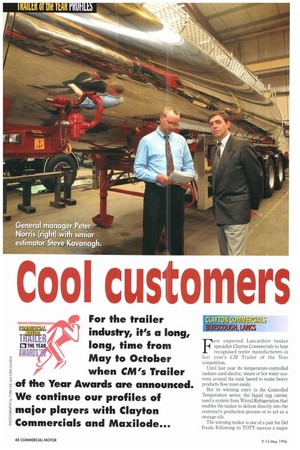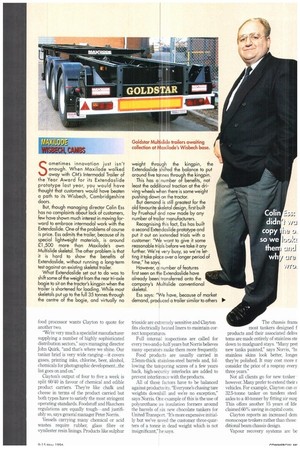Cool customers
Page 50

Page 51

Page 52

If you've noticed an error in this article please click here to report it so we can fix it.
Few expected Lancashire tanker specialist Clayton Commercials to beat recognised reefer manufacturers in last year's CM Trailer of the Year competition.
Until last year its temperature-controlled tankers used electric, steam or hot water systems around the tank barrel to make heavy products flow more easily.
But its winning entry in the Controlled Temperature sector, the liquid egg carrier, used a system from Wirral Refrigeration that enables the tanker to deliver directly into the customer's production process or to act as a storage silo.
The winning tanker is one of a pair for Del Foods. Following its TOTY success a major food processor wants Clayton to quote for another two.
"We're very much a specialist manufacturer supplying a number of highly sophisticated distribution sectors," says managing director John Quirk, "and that's where we shine. Our tanker brief is very wide ranging—it covers gases, printing inks, chlorine, beer, alcohol, chemicals for photographic development. ..the list goes on and on."
Clayton's output of four to five a week is split 60/40 in favour of chemical and edible product carriers. They're like chalk and cheese in terms of the product carried but both types have to satisfy the most stringent operating standards. Foodstuff and Hazchem regulations are equally tough—and justifiably so, says general manager Peter Norris.
Vessels carrying many chemical or acid wastes require rubber, glass fibre or vynilester resin linings. Products like sulphur trioxide are extremely sensitive and Clayton fits electrically heated liners to maintain correct temperatures.
Full internal inspections are called for every two-and-a-half years but Norris believes many operators make them more frequently.
Food products are usually carried in 2.5mm-thick stainless-steel barrels and, following the tampering scares of a few years back, high-security interlocks are added to prevent interference with the products.
All of these factors have to be balanced against productivity. "Everyone's chasing tare weights downhill and we're no exception," says Norris. One example of this is the use of polyurethane as insulation formers around the barrels of six new chocolate tankers for United Transport. "It's more expensive initially but we've saved the customer three-quarters of a tonne in dead weight which is not insignificant," he says.
The chassis fraim most tankers designed f products and their associated deliw tems are made entirely of stainless ste down to mudguard stays. "Many prei new tanks painted," says Norris, "bt stainless skins look better, longet they're polished. It may cost more r consider the price of a respray every three years" Not all clients go for new tanker however. Many prefer to extend their vehicles. For example, Clayton can cc 32.5-tonne tanker on tandem steel. axles to a 40-tanner by fitting air susr This offers another 15 years of life claimed 60% saving in capital costs.
Clayton reports an increased dem inonocoque tankers rather than those clitional beam chassis design.
Vapour recovery systems are be
.4 more common too, particularly for waste chemical carriers, This is in line with the Montreal Protocol which called for reduced gas emissions into the atmosphere by 2010.
Gas and liquid waste tankers have become standard products for Clayton but it is happy to develop specials, such as its Twin Deck whiskey tankers for Mundell and, more recently a pair of foam tankers built on ERF F58 chinese-six rigids for the Greater Manchester fire brigade. They link to other tankers to provide protein foam at major incidents.
The company has also collaborated with Whale Tankers in the Step Vac project—Clayton builds air suspended tri-axle bogies and subframes; Whale adds stepped monocoque tanks for carrying non-hazardous waste.
The design is unique in that the donkey engine and exhauster/compressor are both housed in the nose of the tank.
Over the past 10 years Clayton has invested heavily in design development and production facilities: "We've had to progress to stay ahead of the French and Belgium competition and our product is all the better for it.says Norris. Indeed we're exporting quite a bit ourselves and are aiming to establish agents
in both those countries quite soon." Everything Clayton builds comes with a 40tonne GCW rating and reversible kingpin positions—and they're designed with 44 tonnes in mind. Barrels can be cut and stretched and bogies and pins are in optimum positions for any weight increase.
The road tanker is probably the most efficient commercial vehicle on the road, says Norris, but he is looking forward to the time when the gross limit rises to 44 tonnes. "It's looking politically impossible at the moment," he admits, "but we remain optimistic as ever."
by Bryan Jarvis
















































































































